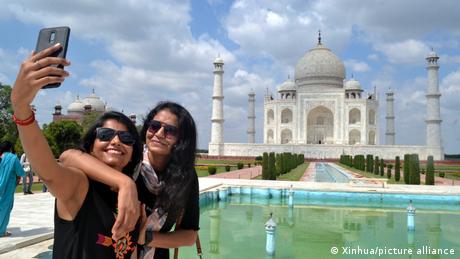COVID: India opens for international travel – what happens next?

After nearly 18 months of closure, India will finally open its borders to fully vaccinated foreign tourists on November 15.
The Home Ministry announced that tourist visas would be issued to those arriving on chartered flights first, whereas travelers on commercial flights would start getting their visas approved from November.
“Foreign tourists entering into India by flights other than chartered aircraft would be able to do so only with effect from November 15, on fresh Tourist Visas,” said a statement from the Home Ministry. Until then, only dedicated cargo flights and commercial flights agreed on in bilateral air bubble pacts would be operating.
Government data shows that international travelers brought in $30 billion (€25.87 billion) in foreign exchange in 2019. After the pandemic and resulting lockdown, earnings fell by over 76%, down to around $7 billion in 2020.
Travel industry looks forward to reopening
“The chain hotels have been able to survive but it has been much harder for smaller enterprises. But now domestic tourists are returning and things are starting to look up,” said Mark, who runs an Airbnb in the travel hub Goa.
“Even though COVID is not over, we are eager to have tourists back, while following all safety protocols,” he told DW. “We don’t expect to go up to pre-pandemic levels anytime soon.”
India’s travel and tourism industry had been deeply impacted by the pandemic. With travel now opening up just in time for the festive season, people working in the sector are optimistic about business picking up pace.
“Unlike other markets, which are thriving ever since the lockdown was lifted, shopkeepers here [at Paharganj market in Delhi] have no business at all, as 80% of the business in the market depended on foreign tourists,” Subhash Vij, president of the Paharganj traders’ body told the Indian newspaper Hindustan Times. The market is usually frequented by backpackers and budget travelers.
Less than 3 million foreign tourists visited India in 2020, a decline of almost 75% compared to the previous year. The government plans to issue 500,000 free visas to boost tourism, which is expected to incentivize short-term travelers to visit India.
“The real impact and damage caused by the pandemic can never be gauged in numbers. It has devastated the travel fraternity, but now we are waiting for brighter times. I would say that a real comparison to assess losses can only be made once the sector fully revives, which I believe will take a minimum of two years,” Jyoti Mayal, President of the Travel Agents Association of India, told DW.
Fear of another wave of infections
After the devastating second wave of coronavirus infections, India’s vaccination rates have picked up and the number of cases remains at a low level. India recently crossed the important landmark ofone billion administered vaccine doses. More than 30% of the eligible population has been fully vaccinated.
“The travel fraternity has been the worst hit due to the pandemic. With the reopening of travel, the travel trade is also gearing up to restart and create jobs and entrepreneurial opportunities. All countries should ideally have coordinated policies, ease of travel, and information must be made available to travelers,” she added.
However, the Indian Council of Medical Research (ICMR) has warned of a potential surge in infections if safety and hygiene protocols are not followed.
“A sudden increase in population density due to incoming tourists or mass congregation due to social, political or religious reasons can worsen the third-wave scenario,” said the ICMR.
The body has suggested surveillance in at-risk areas. In addition, the ICMR wants strict testing procedures to be followed in order to avoid a surge in cases.
SOURCE: DW News








